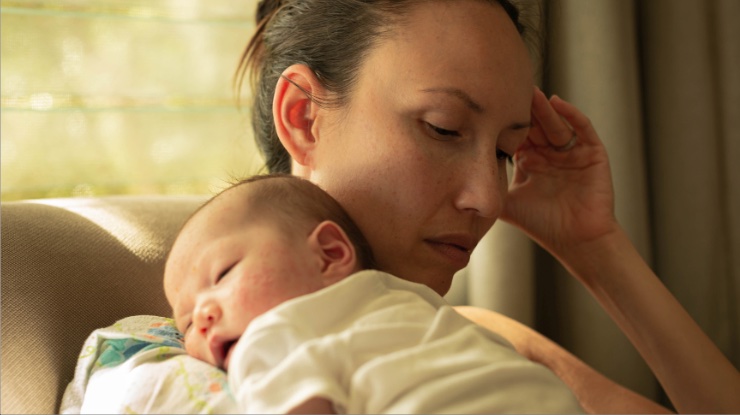
What is postpartum depression and what are the symptoms?
Postpartum depression is one of the most common maternity disorders. However, the fact that it appears after having a baby when the baby takes center stage makes it often invisible. In some areas of the world, the 13th of January marks the World Day Against Depression, so we wanted to highlight this topic.
What is postpartum depression?
Postpartum depression is a type of depression that can appear after childbirth and up to a year later, though according to some experts, it can occur even later.
It is estimated that between 10 and 15% of all mothers will experience postpartum depression, and it seems that the incidence increases for the first baby by up to 25% (1). Some publications state that it may vary according to the population and may be higher in subgroups of the population. For example, it has been seen that for Latina mothers living in Mexico or in the United States, 1 out of every 2 could have postpartum depression. In countries with high economic income, mothers suffer up to three times more of it than in low-income countries (2).
Beyond these statistics, we must remember that postpartum depression comes at a time when it is socially expected to be a time of happiness. It seems that when women have a baby, they must be happy; it almost feels like an obligation. On top of this, there is often a stigma attached to mental health issues. When a new mother has symptoms of postpartum depression, she often also feels guilty for not feeling happy about having a baby, so the actual number of cases of postpartum depression may be higher than the official statistics.
What factors are involved in postpartum depression?
Although postpartum depression can affect all women after giving birth, some factors increase the risk of developing it. Among them are:
- Depression during pregnancy
- Anxiety during pregnancy
- Experiencing stressful life events during pregnancy or in the early postpartum period
- A traumatic birth experience
- Premature birth and/or admission of the newborn to the neonatal intensive care unit (NICU)
- Lack of sleep
- Lack of social support
- History of depression
- Difficulties with breastfeeding
What are the most common symptoms of postpartum depression?
Among the most common symptoms of postpartum depression are:
- Sad, anxious mood or persistent feeling of emptiness
- Irritability
- Feelings of guilt, worthlessness, hopelessness or helplessness
- Loss of interest and pleasure in hobbies and activities
- Fatigue or abnormal decrease in energy levels
- Feeling restless or having trouble sitting still
- Trouble concentrating, remembering, and/or making decisions
- Difficulties falling asleep (even when the baby is sleeping), waking up early in the morning, or sleeping too much
- Increased or decreased appetite and weight changes
- Body aches or pains, headaches, cramps, or digestive problems with no clear physical cause or that do not get better even with proper treatment
- Ongoing doubts about the ability to care for the baby
- Thoughts about death, suicide, or harm to oneself or the newborn child
Postpartum depression goes easily unnoticed because the changes in sleep, fatigue, appetite, and libido, among others, can be mistaken for normal postpartum changes. In addition, mental health assessment is not always done in postnatal check-ups, so many mothers are likely to go undiagnosed and untreated.
Ideally, all professionals who are in contact with women in this crucial time should know how to screen for postpartum depression to make a referral to the appropriate professional to initiate treatment.
What is postpartum depression screening?
There is screening for postpartum depression that allows the identification of the signs of postpartum depression in the women who are screened. This will enable those women who need it to be referred to expert professionals to make a proper diagnosis and start their treatment as soon as possible. One such screening tool is the so-called Edinburgh Scale. We have recently added this test to our LactApp app, where you will be able to take the test yourself. The app is available to download for free for iPhone or Android mobile phones. On the home screen, you can scroll down until you reach the test:

It consists of 10 questions with four answer options that the mother answers about how she felt during the previous seven days. It usually takes less than five minutes to complete. This is a validated scale for screening for postpartum depression after six weeks postpartum. A score above 11 and/or a positive response to question number 10 means that an assessment by a perinatal psychology professional should be recommended.
A clinical examination and the request from the woman are necessary to determine the need for referral to a perinatal psychology professional.
At this point, we would like to remind you that treatment of postpartum depression is safe in breastfeeding, even where the use of medication is necessary. Information on medication and breastfeeding compatibilities is available at www.e-lactancia.org.
References:
(1)Hahn-Holbrook J, Cornwell-Hinrichs T, Anaya I. Economic and health predictors of national postpartum depression prevalence: a systematic review, meta-analysis, and meta-regression of 291 studies from 56 countries. Front Psych. 2018; 8: 248.
(2)Motrico E, Bina R, Domínguez-Salas S, et al. Impact of the Covid-19 pandemic on perinatal mental health (Riseup-PPD-COVID-19): protocol for an international prospective cohort study. BMC Public Health. 2021; 21(1): 1-11.
Depresión perinatal. (s/f). National Institute of Mental Health (NIMH). Recuperado el 10 de enero de 2023, de https://www.nimh.nih.gov/health/publications/espanol/depresion-perinatal
Management of women with mental health issues during pregnancy and the postnatal period (good practice no.14). (s/f). RCOG. Recuperado el 10 de enero de 2023, de https://www.rcog.org.uk/guidance/browse-all-guidance/good-practice-papers/management-of-women-with-mental-health-issues-during-pregnancy-and-the-postnatal-period-good-practice-no14/